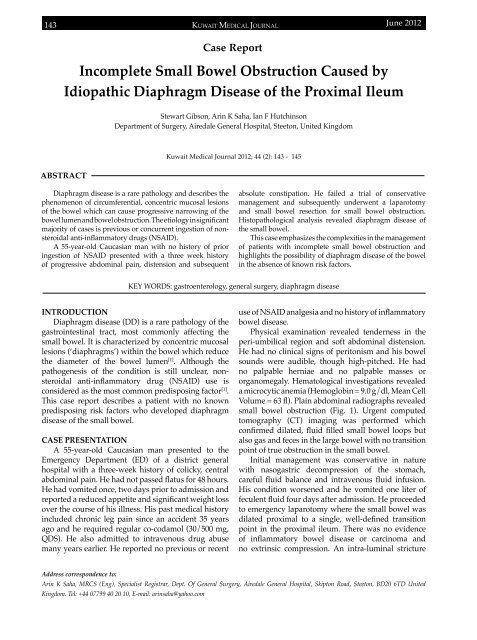Vol 44 # 2 June 2012 - Kma.org.kw
Vol 44 # 2 June 2012 - Kma.org.kw
Vol 44 # 2 June 2012 - Kma.org.kw
Create successful ePaper yourself
Turn your PDF publications into a flip-book with our unique Google optimized e-Paper software.
143<br />
KUWAIT MEDICAL JOURNAL<br />
<strong>June</strong> <strong>2012</strong><br />
Case Report<br />
Incomplete Small Bowel Obstruction Caused by<br />
Idiopathic Diaphragm Disease of the Proximal Ileum<br />
Stewart Gibson, Arin K Saha, Ian F Hutchinson<br />
Department of Surgery, Airedale General Hospital, Steeton, United Kingdom<br />
Kuwait Medical Journal <strong>2012</strong>; <strong>44</strong> (2): 143 - 145<br />
ABSTRACT<br />
Diaphragm disease is a rare pathology and describes the<br />
phenomenon of circumferential, concentric mucosal lesions<br />
of the bowel which can cause progressive narrowing of the<br />
bowel lumen and bowel obstruction. The etiology in significant<br />
majority of cases is previous or concurrent ingestion of nonsteroidal<br />
anti-inflammatory drugs (NSAID).<br />
A 55-year-old Caucasian man with no history of prior<br />
ingestion of NSAID presented with a three week history<br />
of progressive abdominal pain, distension and subsequent<br />
absolute constipation. He failed a trial of conservative<br />
management and subsequently underwent a laparotomy<br />
and small bowel resection for small bowel obstruction.<br />
Histopathological analysis revealed diaphragm disease of<br />
the small bowel.<br />
This case emphasizes the complexities in the management<br />
of patients with incomplete small bowel obstruction and<br />
highlights the possibility of diaphragm disease of the bowel<br />
in the absence of known risk factors.<br />
KEY WORDS: gastroenterology, general surgery, diaphragm disease<br />
INTRODUCTION<br />
Diaphragm disease (DD) is a rare pathology of the<br />
gastrointestinal tract, most commonly affecting the<br />
small bowel. It is characterized by concentric mucosal<br />
lesions (‘diaphragms’) within the bowel which reduce<br />
the diameter of the bowel lumen [1] . Although the<br />
pathogenesis of the condition is still unclear, nonsteroidal<br />
anti-inflammatory drug (NSAID) use is<br />
considered as the most common predisposing factor [1] .<br />
This case report describes a patient with no known<br />
predisposing risk factors who developed diaphragm<br />
disease of the small bowel.<br />
CASE PRESENTATION<br />
A 55-year-old Caucasian man presented to the<br />
Emergency Department (ED) of a district general<br />
hospital with a three-week history of colicky, central<br />
abdominal pain. He had not passed flatus for 48 hours.<br />
He had vomited once, two days prior to admission and<br />
reported a reduced appetite and significant weight loss<br />
over the course of his illness. His past medical history<br />
included chronic leg pain since an accident 35 years<br />
ago and he required regular co-codamol (30/500 mg,<br />
QDS). He also admitted to intravenous drug abuse<br />
many years earlier. He reported no previous or recent<br />
use of NSAID analgesia and no history of inflammatory<br />
bowel disease.<br />
Physical examination revealed tenderness in the<br />
peri-umbilical region and soft abdominal distension.<br />
He had no clinical signs of peritonism and his bowel<br />
sounds were audible, though high-pitched. He had<br />
no palpable herniae and no palpable masses or<br />
<strong>org</strong>anomegaly. Hematological investigations revealed<br />
a microcytic anemia (Hemoglobin = 9.0 g/dl, Mean Cell<br />
<strong>Vol</strong>ume = 63 fl). Plain abdominal radiographs revealed<br />
small bowel obstruction (Fig. 1). Urgent computed<br />
tomography (CT) imaging was performed which<br />
confirmed dilated, fluid filled small bowel loops but<br />
also gas and feces in the large bowel with no transition<br />
point of true obstruction in the small bowel.<br />
Initial management was conservative in nature<br />
with nasogastric decompression of the stomach,<br />
careful fluid balance and intravenous fluid infusion.<br />
His condition worsened and he vomited one liter of<br />
feculent fluid four days after admission. He proceeded<br />
to emergency laparotomy where the small bowel was<br />
dilated proximal to a single, well-defined transition<br />
point in the proximal ileum. There was no evidence<br />
of inflammatory bowel disease or carcinoma and<br />
no extrinsic compression. An intra-luminal stricture<br />
Address correspondence to:<br />
Arin K Saha, MRCS (Eng), Specialist Registrar, Dept. Of General Surgery, Airedale General Hospital, Skipton Road, Steeton, BD20 6TD United<br />
Kingdom. Tel: +<strong>44</strong> 07799 40 20 10, E-mail: arinsaha@yahoo.com
















